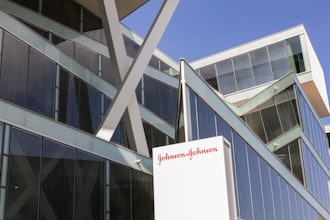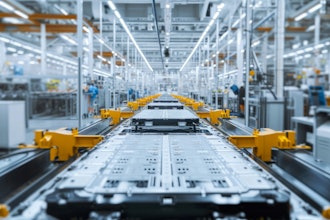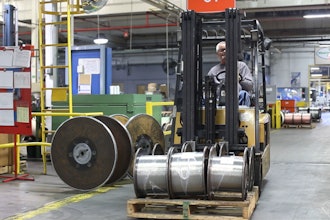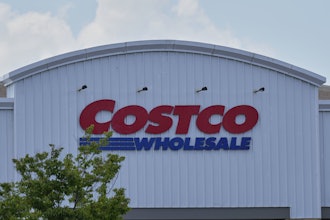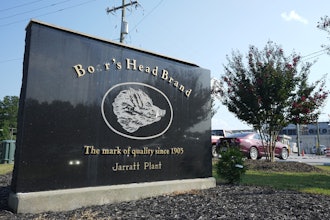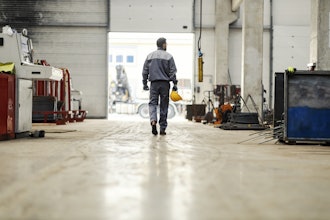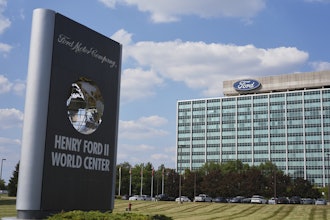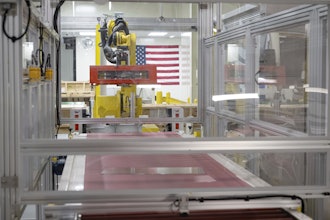With one digester already in place, Schmack BioEnergy looks to expand the use of its technology for converting biowaste to energy.
By Jeff Reinke
There are plenty of clichés about how difficult situations can serve a useful purpose in pushing a company, team or individual forward. In looking at the origins of Schmack BioEnergy in northern Ohio you can take your pick, because they would all seem to apply.
The story begins at the KB Compost Services plant in Akron. For years this company received a steady supply of bulk material directly from the city’s wastewater treatment facility across the river. KB Compost treats the material by combining it with sawdust to produce soil conditioner. Over the course of several years, however, this process began to take its toll on both the company and the facility itself.
The 15-acre plant has six holding wells with a combined 450,000-gallon capacity in de-watering 70 million gallons of sludge, or transforming 50,000 wet tons, into compost each year. So while the process is completely contained, and the air itself is treated within the facility, there were still a number of impacts being felt due to the sheer mass of material being handled.
First, a significant amount of ammonia and water were getting into the building’s beams, thereby corroding them, which meant that significant infrastructure investments needed to be made. Secondly, the only cost the company had incurred for the sawdust was transportation to its facility. However, this dynamic changed when mills began to charge for sawdust—and prices have increased significantly in recent years. For a plant that consumes around 100,000 cubic yards annually, these costs had a critical impact on the entire operation. Finally, sulfuric acid prices have jumped more than 700 percent, also impacting operational overhead.
These infrastructure changes led the company to seek out new processing solutions that could help curb costs and improve overall operations. In 2006, Kurtz found its answer in a 15-year-old German company that operates more than 250 biogas facilities throughout Europe.
The company, Schmack BioEnergy, has been a pioneer in developing an anaerobic digestion technology that converts biowaste materials to a gas that is 60 percent methane. This energy source can be used to generate natural gas for heating, motor vehicle fuel in the form of compressed natural gas (CNG), or electricity.
The process appeared to be the right fit to address KB’s situation. Not only would the company reduce its sawdust and transportation costs, but also produce a viable energy source that could be used on-site, lessening the plant’s dependence on energy from the grid.
Furthermore, the feedstock was a good fit because the composting plant receives a solid mix that is both homogenous and virtually unprocessed. This means that the company can take greater control of the process and implement more efficient approaches in feeding the Schmack digester.
Construction of two large digesters began in early 2006, with actual operation of the technology initiating in November of 2007. While the equipment is simple enough—three pumps with enclosed mixers and 160,000- and 550,000-gallon tanks, the process was not.
KB Compost’s Vice President of Operations Annette Berger explains, “While the end result has been very positive, it was a challenging process. At times I felt like we were a bobber in the ocean—somewhat isolated, yet still floating along doing what we needed to do.
“The biggest challenge,” Berger continues, “stemmed from cultural issues with German engineers. The metric to English conversions made a lot of the construction very interesting. Also, in Germany, Schmack deals primarily with agricultural waste—manure and corn silage—so adjusting things to handle sewage sludge called for adjusting the operational dynamics.
“There were unique safety concerns, EPA regulations to accommodate and even just getting training manuals translated into English proved to be an obstacle. We also had to re-evaluate our work force to ensure we had people who were able to understand the greater reliance on instrumentation readings, due to the enclosed nature of the equipment. We also had to establish a comfort level with new types of monitoring and maintenance technology.”
The relationship between Schmack in Germany and Schmack BioEnergy in the U.S. is also somewhat unique. The situation is similar to a franchise, but the Akron facility does not have to take direction from its German counterpart. Rather, it’s closer to a complicated licensing agreement that the Cleveland-based company uses to install and manage the technology throughout the U.S.
Although both operations use the same approach, whether in Europe or the U.S., the two companies are independent of each other. The connection does, however, still come into play as German engineers constantly monitor the KB facility and contact Berger if a problem is encountered.
While the process was not easy, Berger has no problems pointing to the benefits that have been realized, especially now that the digester has been online for just over a year. Some benefits include:
While the digester at the KB Compost facility is a success, the next step is a more independent operation that would produce enough energy to sell back to the grid. This is the challenge, which will hopefully be realized with a unit currently under construction in Columbus, for the Cleveland-based company and President Mel Kurtz. It is set to begin operation in 2009.
“We’re looking to change the way we live," states Kurtz. We’re offering a solution that uses all organic waste and, among other things, has the potential to provide as much as 25 percent of the necessary automotive fuel needed by this country (in the form of CNG). In some instances it only takes one gallon of this biowaste feedstock to create as much as 3 liters of CNG. The challenge is establishing an infrastructure for this energy source, as well as others. We’re not only building a company; in many ways, we’re building an industry.”
A big boost to Schmack’s northern Ohio operation are recently established partnerships with The Ohio State University and its Agricultural Research and Development Center (OARDC), in addition to the Ohio BioProducts Innovation Center at the OARDC campus in nearby Wooster, OH. The collaboration resulted in the development of a new engineering and laboratory facility that allows for testing this and other organic waste feedstocks, such as food by-products, in further developing their energy potential.
OARDC’s overall mission is to promote successful agricultural initiatives and help Ohio farmers in general. This blends well with Schmack’s goals for wider-spread use of biogas-processing technology. “We want to not only build new plants to help facilities like KB, but also establish stand-alone digesters that can produce energy for mass consumption,” states Kurtz. Manure could be a key part of the feedstocks used for this process, as it is in Germany. The difference right now is an infrastructure that incentivizes farmers to collect this material and participate in such a program does not exist. Ideally, with greater education and stakeholder support, farmers could become more involved and play a key role in helping to push this program forward.
Because government-based incentives are not in place, as they are in Europe, tip fees are being paid by companies like Schmack in order to obtain these waste materials. Formerly something that farmers or food processors would pay to be rid of, these by-products have now become a profit center.“The location of everything came together in providing a real target of opportunity,” adds Clemens Halene, Schmack’s Vice President of Engineering. “We have the technology, but OSU has a built-in infrastructure for helping us take the next step. Eventually, we want to build a Farm Digester on campus.”
While initiatives like this partnership and the Columbus digester help grow support for Schmack’s work, there are still other obstacles. Constructing the new digester has come with its own challenges, in part because there is not a U.S. marketplace for the type of equipment that Schmack needs. So the company must work with German suppliers, retrofit current products or actually design its own solutions. However, Halene finds that working with tank and pump experts in the wastewater management industry has been very helpful, and the company ultimately wants to have all U.S. suppliers.
“If we could digest the corn that is currently going towards ethanol production, we would get four times the energy value,” states Kurtz. "Still, people are skeptical. I compare it to an old water pump. You really have to work the handle in order to prime that pump, but once the water comes, it’s clean and cold, and flowing fast. I think that’s where we’re at. We keep priming the pump because we know once things get rolling, it’s going to be positive for everyone involved.”
Aiding the development of the technology in Europe, which has nearly 4,000 similar digesters either under construction or in operation, was government support. In the U.S., Schmack and companies like it have come to echo the mantra of, “If you build it, we will come.” This makes the success of any and all projects vital to their future.
“It’s a 15-year-old industry in Europe, and the U.S. treats it like it’s brand new,” states Halene. “Our technology is proven, but people still want to know if we’ll be here tomorrow. So it’s important not only that we’re successful, but so are others in this marketplace. If one of us fails, it hurts the credibility of everyone.”
The 15-acre plant has six holding wells with a combined 450,000-gallon capacity in de-watering 70 million gallons of sludge, or transforming 50,000 wet tons, into compost each year. So while the process is completely contained, and the air itself is treated within the facility, there were still a number of impacts being felt due to the sheer mass of material being handled.
First, a significant amount of ammonia and water were getting into the building’s beams, thereby corroding them, which meant that significant infrastructure investments needed to be made. Secondly, the only cost the company had incurred for the sawdust was transportation to its facility. However, this dynamic changed when mills began to charge for sawdust—and prices have increased significantly in recent years. For a plant that consumes around 100,000 cubic yards annually, these costs had a critical impact on the entire operation. Finally, sulfuric acid prices have jumped more than 700 percent, also impacting operational overhead.
Schmack Talk
The company, Schmack BioEnergy, has been a pioneer in developing an anaerobic digestion technology that converts biowaste materials to a gas that is 60 percent methane. This energy source can be used to generate natural gas for heating, motor vehicle fuel in the form of compressed natural gas (CNG), or electricity.
The process appeared to be the right fit to address KB’s situation. Not only would the company reduce its sawdust and transportation costs, but also produce a viable energy source that could be used on-site, lessening the plant’s dependence on energy from the grid.
Furthermore, the feedstock was a good fit because the composting plant receives a solid mix that is both homogenous and virtually unprocessed. This means that the company can take greater control of the process and implement more efficient approaches in feeding the Schmack digester.
Construction of two large digesters began in early 2006, with actual operation of the technology initiating in November of 2007. While the equipment is simple enough—three pumps with enclosed mixers and 160,000- and 550,000-gallon tanks, the process was not.
KB Compost’s Vice President of Operations Annette Berger explains, “While the end result has been very positive, it was a challenging process. At times I felt like we were a bobber in the ocean—somewhat isolated, yet still floating along doing what we needed to do.
“The biggest challenge,” Berger continues, “stemmed from cultural issues with German engineers. The metric to English conversions made a lot of the construction very interesting. Also, in Germany, Schmack deals primarily with agricultural waste—manure and corn silage—so adjusting things to handle sewage sludge called for adjusting the operational dynamics.
“There were unique safety concerns, EPA regulations to accommodate and even just getting training manuals translated into English proved to be an obstacle. We also had to re-evaluate our work force to ensure we had people who were able to understand the greater reliance on instrumentation readings, due to the enclosed nature of the equipment. We also had to establish a comfort level with new types of monitoring and maintenance technology.”
The relationship between Schmack in Germany and Schmack BioEnergy in the U.S. is also somewhat unique. The situation is similar to a franchise, but the Akron facility does not have to take direction from its German counterpart. Rather, it’s closer to a complicated licensing agreement that the Cleveland-based company uses to install and manage the technology throughout the U.S.
Although both operations use the same approach, whether in Europe or the U.S., the two companies are independent of each other. The connection does, however, still come into play as German engineers constantly monitor the KB facility and contact Berger if a problem is encountered.
While the process was not easy, Berger has no problems pointing to the benefits that have been realized, especially now that the digester has been online for just over a year. Some benefits include:
- The odor and corrosive impact on the facility have been reduced.
- The Schmack digester processes about 5,000 dry tons annually. A
- bout 335 kilowatt hours of energy is generated, covering 10 percent of the plant’s energy costs.
- The remaining electricity helps reduce the demand placed on the facility, generating a savings of about $15,000 per month.
The Next Step—Building An Industry
“We’re looking to change the way we live," states Kurtz. We’re offering a solution that uses all organic waste and, among other things, has the potential to provide as much as 25 percent of the necessary automotive fuel needed by this country (in the form of CNG). In some instances it only takes one gallon of this biowaste feedstock to create as much as 3 liters of CNG. The challenge is establishing an infrastructure for this energy source, as well as others. We’re not only building a company; in many ways, we’re building an industry.”
A big boost to Schmack’s northern Ohio operation are recently established partnerships with The Ohio State University and its Agricultural Research and Development Center (OARDC), in addition to the Ohio BioProducts Innovation Center at the OARDC campus in nearby Wooster, OH. The collaboration resulted in the development of a new engineering and laboratory facility that allows for testing this and other organic waste feedstocks, such as food by-products, in further developing their energy potential.
OARDC’s overall mission is to promote successful agricultural initiatives and help Ohio farmers in general. This blends well with Schmack’s goals for wider-spread use of biogas-processing technology. “We want to not only build new plants to help facilities like KB, but also establish stand-alone digesters that can produce energy for mass consumption,” states Kurtz. Manure could be a key part of the feedstocks used for this process, as it is in Germany. The difference right now is an infrastructure that incentivizes farmers to collect this material and participate in such a program does not exist. Ideally, with greater education and stakeholder support, farmers could become more involved and play a key role in helping to push this program forward.
Because government-based incentives are not in place, as they are in Europe, tip fees are being paid by companies like Schmack in order to obtain these waste materials. Formerly something that farmers or food processors would pay to be rid of, these by-products have now become a profit center.“The location of everything came together in providing a real target of opportunity,” adds Clemens Halene, Schmack’s Vice President of Engineering. “We have the technology, but OSU has a built-in infrastructure for helping us take the next step. Eventually, we want to build a Farm Digester on campus.”
While initiatives like this partnership and the Columbus digester help grow support for Schmack’s work, there are still other obstacles. Constructing the new digester has come with its own challenges, in part because there is not a U.S. marketplace for the type of equipment that Schmack needs. So the company must work with German suppliers, retrofit current products or actually design its own solutions. However, Halene finds that working with tank and pump experts in the wastewater management industry has been very helpful, and the company ultimately wants to have all U.S. suppliers.
“If we could digest the corn that is currently going towards ethanol production, we would get four times the energy value,” states Kurtz. "Still, people are skeptical. I compare it to an old water pump. You really have to work the handle in order to prime that pump, but once the water comes, it’s clean and cold, and flowing fast. I think that’s where we’re at. We keep priming the pump because we know once things get rolling, it’s going to be positive for everyone involved.”
Aiding the development of the technology in Europe, which has nearly 4,000 similar digesters either under construction or in operation, was government support. In the U.S., Schmack and companies like it have come to echo the mantra of, “If you build it, we will come.” This makes the success of any and all projects vital to their future.
“It’s a 15-year-old industry in Europe, and the U.S. treats it like it’s brand new,” states Halene. “Our technology is proven, but people still want to know if we’ll be here tomorrow. So it’s important not only that we’re successful, but so are others in this marketplace. If one of us fails, it hurts the credibility of everyone.”




